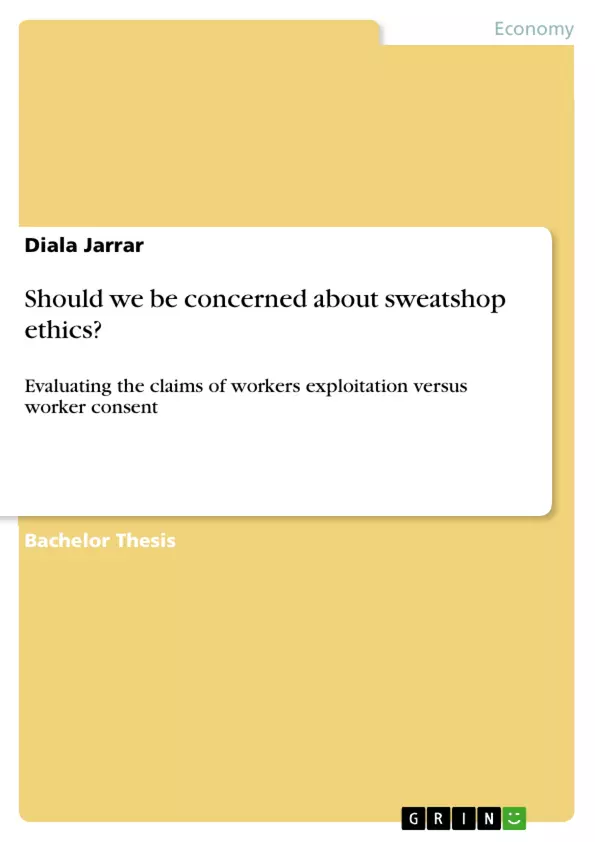Sweatshops are have been violating our notions of justice. Although there has been an increased concern on their ethics, they continue to flourish. MNEs claim that workers chose to accept the conditions of their employment therefore making it to an extent ‘ethical’. The workers’ choice to accept such conditions is very significant, representing their ability to exercise their autonomy and is an expression of their preferences. The following claims made by MNEs stand supported by sweatshop labor’s consents towards approving harmful conditions yet it may be not as voluntary as it seem. Although sweatshops are wrongfully exploitative and defend the harmful conditions through claiming that workers accept those conditions, they are still of benefit to labor. Sweatshops provide employment for many poor people, improve their standards of living, and exempt them away from poverty wage spiral. Should workers’ choices to accept conditions be respected by third parties? Alternatively, Should we be concerned about ‘ethics’ of sweatshops?
Table of Contents
- Acknowledgement
- Abstract
- Chapter 1:
- Introduction
- Chapter 2:
- Aims and Objectives
- Scope
- Chapter 3:
- Literature Review
- Power of Choice
- Sweatshops- Exploitation or Opportunity
- Hypotheses
- Chapter 4:
- Findings and Analysis
- Results &Discussions
- Chapter 5:
- Conclusion
Objectives and Key Themes
This research paper aims to analyze the ethical issues surrounding sweatshops by exploring the contrasting viewpoints of worker exploitation and worker consent. The study aims to evaluate the moral significance of worker consent, examine the arguments for and against sweatshops, and investigate the influence of moral intensity dimensions, particularly magnitude of consequences and proximity, on individuals' ethical decisions and purchasing patterns related to sweatshops.
- The moral significance of worker consent
- The arguments for and against sweatshops: exploitation versus opportunity
- The role of moral intensity dimensions (magnitude of consequences and proximity) in ethical decision-making
- The impact of ethical concerns on purchasing patterns
- The ethical responsibilities of multinational enterprises (MNEs) in the sweatshop context
Chapter Summaries
Chapter 1: Introduction introduces the ethical dilemma of sweatshops, highlighting the contrasting perspectives on their impact. It emphasizes the importance of studying moral intensity and its influence on ethical decision-making.
Chapter 2: Aims and Objectives outlines the research goals, focusing on evaluating the key ethical issues associated with sweatshops, examining workers' consents against exploitation, and assessing the role of moral intensity dimensions in ethical decision-making.
Chapter 3: Literature Review explores the transformative power of choice, particularly in the context of sweatshop labor. It presents arguments for both the exploitative nature of sweatshops and the opportunity they provide for workers, considering ethical frameworks like Kantian ethics and Utilitarianism.
Chapter 4: Findings and Analysis examines the data collected from a focus group, exploring the correlation between magnitude of consequences and purchasing patterns, and the inverse correlation between proximity and purchasing behaviors.
Chapter 5: Conclusion summarizes the findings, suggesting that while sweatshops might not be entirely ethical, their abolition could lead to worse outcomes for workers. It highlights the need for government oversight and responsible media portrayals to address the ethical concerns surrounding sweatshops.
Keywords
Sweatshops, ethics, worker consent, worker exploitation, moral intensity, magnitude of consequences, proximity, purchasing patterns, multinational enterprises (MNEs), Kantian ethics, Utilitarianism, autonomy, freedom of choice, poverty, development, media framing, ethical decision-making.
- Citation du texte
- Diala Jarrar (Auteur), 2017, Should we be concerned about sweatshop ethics?, Munich, GRIN Verlag, https://www.grin.com/document/938371



